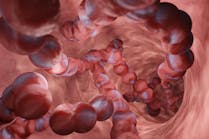The first few words of Dr. John Brunstein’s “Primer” article in this issue (page 28) include an enigmatic reference: “In the decades immediately following the Watson, Crick (and Franklin) elucidation of the DNA structure….”
Franklin? Is the estimable Brunstein suggesting that old Ben, in addition to writing Poor Richard’s Almanac and inventing bifocals and the lightning rod, played a role in describing the double helix?
Nope, we’re talking here about a different Franklin. British molecular biologist Rosalind Franklin (1920-1958) was a colleague of James Watson and Francis Crick. She played an important role in the development of the model of the DNA molecule, and she has been slighted by the history of science. I think that John Brunstein included his parenthetical aside in an attempt to do his part to give Rosalind Franklin the credit that her tragic early death—and perhaps a somewhat sexist scientific community—denied her.
Rosalind Elsie Franklin decided to become a scientist when she was a teenager, overcame parental resistance, and earned a doctorate in chemistry from Cambridge University in 1945. During the next few years, she learned x-ray diffraction techniques at the Laboratoire Central des Services Chimiques de L’Etat in Paris, and then became a research associate in the laboratory of the biophysicist John Randall at King’s College, London, in 1951. There, she worked on a project to discover the structure of DNA, and used x-rays technology to create images of the molecule. Her refinement of x-ray diffraction techniques enabled her to make significant discoveries about DNA. Reportedly, she achieved this despite being patronized and treated like an underling by some of her male colleagues, including her close colleague at King’s, physicist and molecular biologist Maurice Wilkins
Her work dovetailed with research that Watson and Crick were doing, and, according to one source, a website sponsored by the San Diego Supercomputer Center, she may have played a key role in Watson’s groundbreaking description of the structure of DNA:
“At one point, Wilkins showed Watson one of Franklin’s crystallographic portraits of DNA. When he saw the picture, the solution became apparent to him, and the results went into an article in Nature almost immediately. Franklin’s work did appear as a supporting article in the same issue of the journal.” (https://www.sdsc.edu/ScienceWomen/franklin.html)
So, did Watson fail to give Franklin sufficient credit for “Photo 51” and its impact on one of the great scientific triumphs of the twentieth century, the identification of the molecular structure of DNA? The answer to that question is debatable, and it has been debated. Certainly, the 1987 book Rosalind Franklin and DNA, by writer Anne Sayre, argues forcefully that Franklin’s role has been underappreciated.
In truth, there is a lot of gamesmanship when it comes to publication at the highest levels of scientific research, and power struggles, and rivalries and races to publish first. Most of this has nothing to do with sexism, but with a more gender-neutral competitiveness. Some cases may have been wrapped up in sexism too, however, in past times when women’s contributions tended to be diminished or denied. Let’s hope those times are over and done with, consigned to the proverbial dustbin of history. In science as in every other aspect of human life, “women hold up half the sky.”
One question we can never know the answer to: If Rosalind Franklin had not died (at 37!) of ovarian cancer, would she have shared the Nobel Prize in Physiology or Medicine with Watson, Crick, and Wilkins when they were awarded it in 1962? Only living people are eligible for the Nobel Prize.




